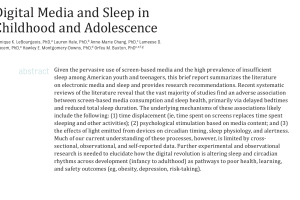Abstract
Given the pervasive use of screen-based media and the high prevalence of insufficient sleep among American youth and teenagers, this brief report summarizes the literature on electronic media and sleep and provides research recommendations. Recent systematic reviews of the literature reveal that the vast majority of studies find an adverse association between screen-based media consumption and sleep health, primarily via delayed bedtimes and reduced total sleep duration. The underlying mechanisms of these associations likely include the following: (1) time displacement (ie, time spent on screens replaces time spent sleeping and other activities); (2) psychological stimulation based on media content; and (3) the effects of light emitted from devices on circadian timing, sleep physiology, and alertness.
Much of our current understanding of these processes, however, is limited by crosssectional, observational, and self-reported data. Further experimental and observational research is needed to elucidate how the digital revolution is altering sleep and circadian rhythms across development (infancy to adulthood) as pathways to poor health, learning, and safety outcomes (eg, obesity, depression, risk-taking).
This article was published in a special 2017 supplement of Pediatrics, a journal of the American Academy of Pediatrics. The supplement, “Children, Adolescents and Screens: What We Know and What We Need To Learn,” was produced by Children and Screens and includes the contributions of more than 130 interdisciplinary authors across 22 papers. See a complete list of articles included in the supplement.
